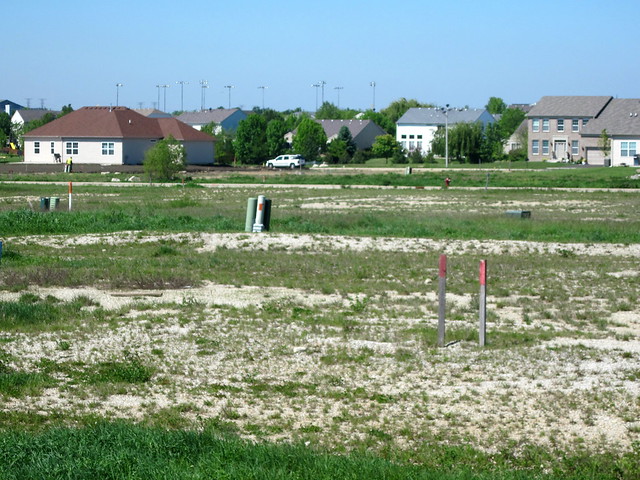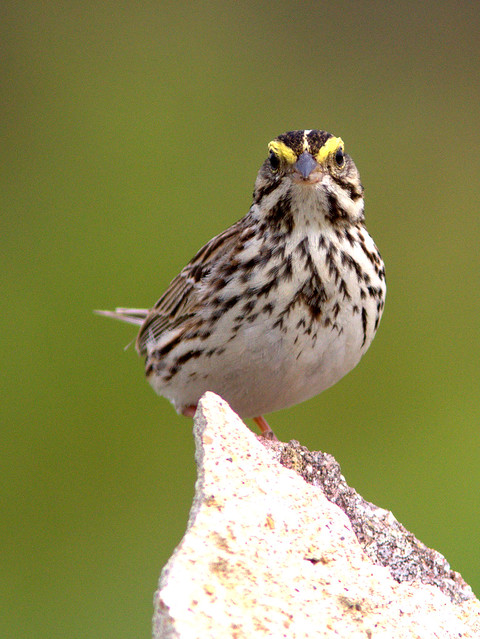The car can serve as a very effective blind (or hide). One morning earlier this week, with thunder in the background, I drove around the vacant block in front of our northeastern Illinois condo. We are partially surrounded by three city block-sized parcels of land that, within the next week or so, will start to be built up into townhouses. In what was formerly a cornfield, roads and utilities had been installed and 44 of the planned 144 units were finished before the housing slump halted development in 2006.
This is the view from our front door, looking west. Not very pleasing to most folks, but I enjoy all the birds that visit and nest there. After the snow melts and the spring rains come, several large puddles (”fluddles”) attract ducks, geese, cranes and wading birds. The utility markers serve as perches for a variety of prairie birds.
Earlier that morning, I had heard both a Spotted Sandpiper and a Vesper Sparrow singing. Both have nested here in the past, but within a few days, ground will be broken for the remaining 100 new townhouses on this site. Almost immediately I found the sandpiper atop a favorite rock pile, but it flew away as I readied my camera, only to be replaced by a Savannah Sparrow.
The amount of yellow in their eyebrows differs in the several subspecies that breed across the US. The local birds have very prominent yellow brows.
I found the sandpiper again further away in a fluddle across the street.
The sandpipers have nested in the vacant lots every spring since we moved here in 2007. Last year, this one posed on a rock pile.
I had given up the search for the Vesper Sparrow, but stopped in front of our condo to get the mail that I forgot to pick up the day before. I heard it singing on another rock pile and drove back. It posed briefly before disappearing, just as rain started falling.
This streaked Vesper Sparrow shows its characteristic white outer tail feathers and a reddish shoulder patch.
Other species that have nested in this field in past years include Killdeer, Red-winged Blackbird, Eastern Meadowlark, Dicksissel, Song Sparrow and Horned Lark. I had not seen the latter species until a couple of days ago. It’s sad to think that their homes will probably be gone before the end of breeding season.
I photographed an American Kestrel from our front door as it hunted for grasshoppers.
This Eastern Meadowlark appeared to have a swollen ‘ankle.”
A pair of Red-tailed Hawks shared a street light pole.
Late that afternoon, we were leaving our condo to join our daughter and family for dinner. Mary Lou suggested I put the camera in the car instead of storing it in the trunk, as almost every time we pass the vacant lot in front of our building we see interesting birds perched on the posts and rock piles along the road. Sure enough, this Horned Lark posed for several minutes in perfect light.
These are the first photos I have processed on my new wide-screen LCD monitor, a gift from our son-in-law. It is attached to the clunky laptop, and in reviewing my recent shots on FLICKR I can see how poorly I have been able to gauge their quality on the laptop’s murky screen. I also have switched from shooting in RAW, as the laptop’s memory can barely handle the large file size.
In our daughter’s back yard, as I was BBQ’ing fajitas, I heard a Savannah Sparrow singing. I ran for my camera and caught the Savannah Sparrow perching on the fence rail. As I was taking this shot, it stopped moving and cast an anxious glance skyward.
I also looked up to find a Red-tailed hawk soaring overhead, hardly a threat to so small a bird, but enough to trigger its instinct to freeze in place to avoid detection.
A Chipping Sparrow displaced the Savannah Sparrow on the fence and then perched on the tip of a small Blue Spruce tree in their next door neighbor’s yard.




























